The Intel Core i9-7980XE and Core i9-7960X CPU Review Part 1: Workstation
by Ian Cutress on September 25, 2017 3:01 AM ESTBenchmarking Performance: CPU Legacy Tests
Our legacy tests represent benchmarks that were once at the height of their time. Some of these are industry standard synthetics, and we have data going back over 10 years. All of the data here has been rerun on Windows 10, and we plan to go back several generations of components to see how performance has evolved.
All of our benchmark results can also be found in our benchmark engine, Bench.
3D Particle Movement v1
3DPM is a self-penned benchmark, taking basic 3D movement algorithms used in Brownian Motion simulations and testing them for speed. High floating point performance, MHz and IPC wins in the single thread version, whereas the multithread version has to handle the threads and loves more cores. This is the original version, written in the style of a typical non-computer science student coding up an algorithm for their theoretical problem, and comes without any non-obvious optimizations not already performed by the compiler, such as false sharing.


CineBench 11.5 and 10
Cinebench is a widely known benchmarking tool for measuring performance relative to MAXON's animation software Cinema 4D. Cinebench has been optimized over a decade and focuses on purely CPU horsepower, meaning if there is a discrepancy in pure throughput characteristics, Cinebench is likely to show that discrepancy. Arguably other software doesn't make use of all the tools available, so the real world relevance might purely be academic, but given our large database of data for Cinebench it seems difficult to ignore a small five minute test. We run the modern version 15 in this test, as well as the older 11.5 and 10 due to our back data.
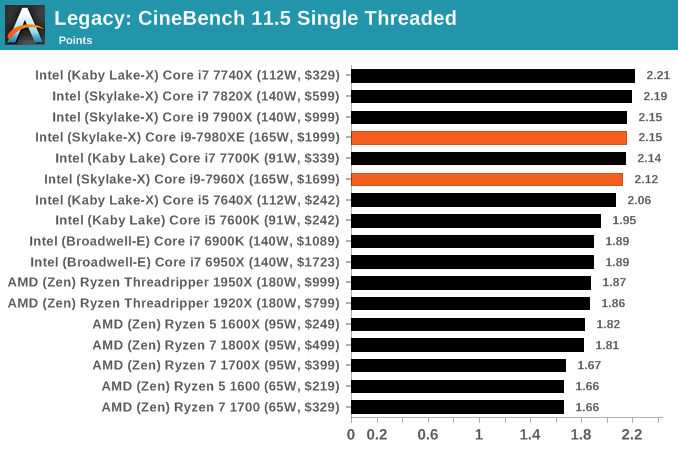
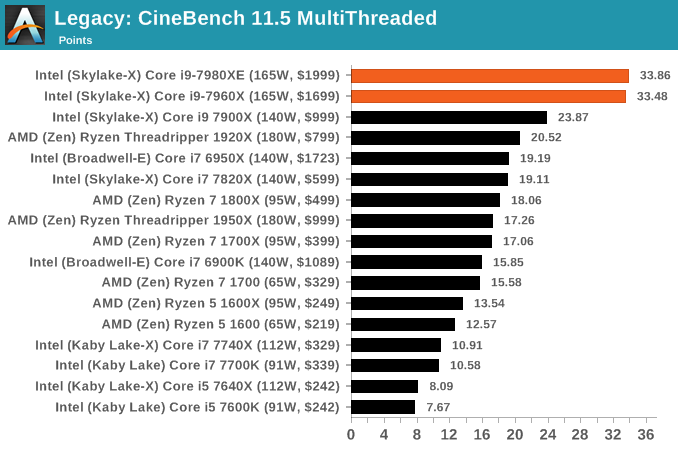
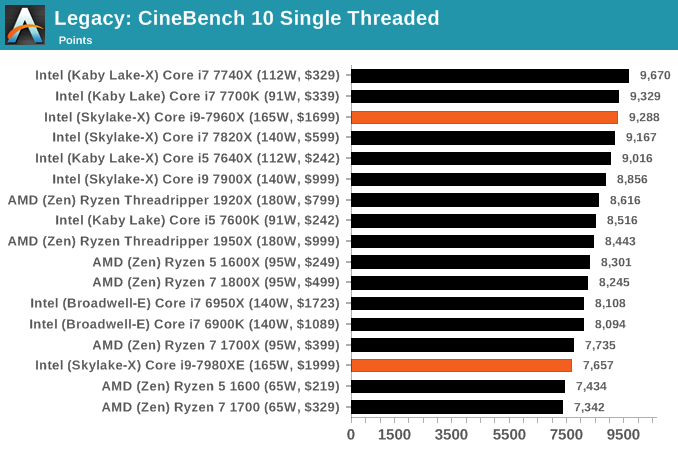
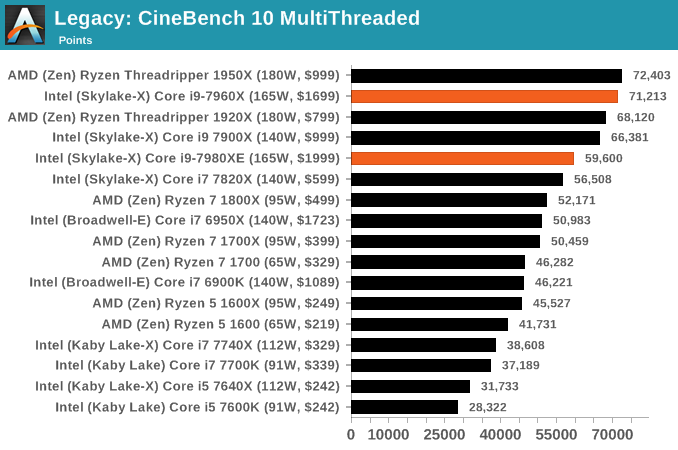
x264 HD 3.0
Similarly, the x264 HD 3.0 package we use here is also kept for historic regressional data. The latest version is 5.0.1, and encodes a 1080p video clip into a high quality x264 file. Version 3.0 only performs the same test on a 720p file, and in most circumstances the software performance hits its limit on high end processors, but still works well for mainstream and low-end. Also, this version only takes a few minutes, whereas the latest can take over 90 minutes to run.
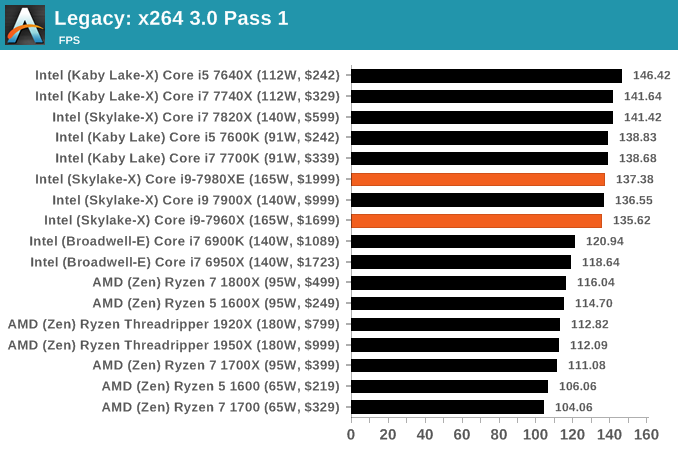
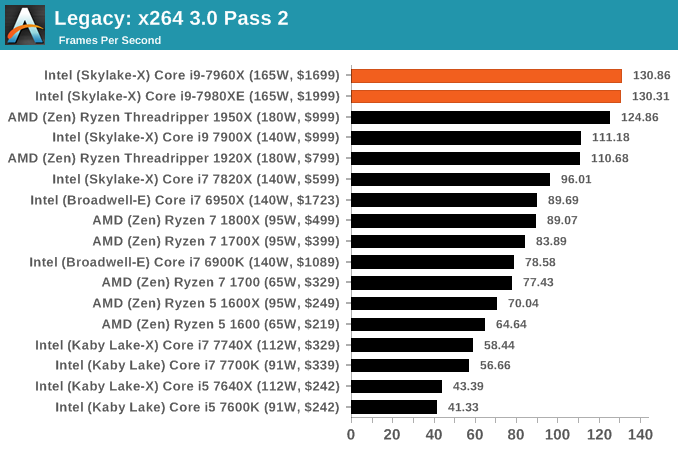










152 Comments
View All Comments
tamalero - Wednesday, September 27, 2017 - link
Hey guys, question.. Toms and others have mentioned that they HAD to put watercooling to keep this thing stable.Did the same happened to your sample? Wouldnt that increase the "cost of ownership" even more than the intel counterpart?
I mean, the mobo, the ram, the watercooling kit and then the hefty processor?
samer1970 - Wednesday, September 27, 2017 - link
Water cooling is for overclocking only ... you will be okay using 170 watt TDP rated air cooler if you dont oc.0ldman79 - Wednesday, September 27, 2017 - link
I'm going to grab another cup-o-coffee and read it again, but the performance per dollar, AMD costs about half as much as Intel for several comparable models, how does Intel have better performance per dollar on so many of those graphs?Admittedly my kids are driving me nuts and I've been reading this for two days now trying to finish...
silvertooth82 - Thursday, September 28, 2017 - link
if this is all true... let's say thanks to AMD for poking IntelAnnonymousCoward - Friday, September 29, 2017 - link
Very nice review. So compared to a 6700K/7700K, the 18-core beast is marginally slower in single-thread, and only 2-3x faster in multi-thread.I found the time difference when opening the big PDF to be the most interesting chart. 65W Ryzens take a noticable extra second.
Exceeding the published TDP sounds like lawsuit territory.
nufear - Monday, October 2, 2017 - link
Price for Intel Core i9-7980XE and Core i9-7960XMy opinion, I can not justify to spend extra $700~1k on these processors. The performances weren't that significant.
rwnrwnn7 - Wednesday, October 4, 2017 - link
AVX-512 - What software work with him?for what it used today?
rwnrwnn7 - Wednesday, October 4, 2017 - link
AVX-512 - What software work with him?for what it used today?
DoDidDont - Friday, October 27, 2017 - link
Would have been nice to see the Xeon Gold 6154 in the test. 18 cores / 36 threads and apparently an all core turbo of 3.7Ghz, plus the advantage of adding a second one on a dual socket Mobo.Planning a pair of 6154's on either an Asus WS C621E or a Supermicro X11DPG-QT and Quad GPU set up.
My 5 year old dual E5-2687w system scores 2298 in Cinebench R15, which has served me well and paid for itself countless times over, but having dual 6154's will bring a huge smile to the face for V-ray production rendering.
My alternative is to build two systems on the i9-7980XE, one for content creation, single CPU, single GPU, and the other as a GPU workhorse for V-ray RT, and Iray, single CPU, Quad GPU+ to call on when needed.
So the comparison would have been nice for the various tests performed.
sharath.naik - Sunday, December 3, 2017 - link
Isn't there supposed to be part 2!!!